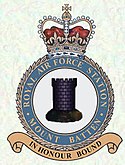| RAF Mount Batten | |
|---|---|
| Plymouth Sound, Devon, England | |
 "In Honour Bound" | |
| Site information | |
| Type | Seaplane Station and Flying Boat base |
| Owner | Ministry of Defence |
| Operator | Royal Naval Air Service Royal Air Force |
| Condition | Closed |
| Location | |
| Coordinates | 50°21′32″N4°07′48″W / 50.35889°N 4.13000°W |
| Site history | |
| In use | 1917[ citation needed ]–4 July 1992 [1] |
| Battles/wars | First World War Second World War |
Royal Air Force Mount Batten, or more simply RAF Mount Batten, is a former Royal Air Force station and flying boat base at Mount Batten, a peninsula in Plymouth Sound, Devon, England, UK. Originally a seaplane station opened in 1917 as a Royal Navy Air Service Station Cattewater it became RAF Cattewater in 1918 and in 1928 was renamed RAF Mount Batten. The base is named after Captain Batten, a Civil War commander who defended this area at the time, with the Mountbatten family motto In Honour Bound taken as the station's motto. [2] [3]
Contents
- History
- Royal Naval Air Station Cattewater
- Royal Air Force Cattewater
- Royal Air Force Mount Batten
- RAF units and aircraft
- References
- Citations
- Bibliography
Today, little evidence of the RAF base remains apart from several memorials, some aviation-related road names, the main slipway and two impressive Grade II listed F-type aeroplane hangars dating from 1917.



